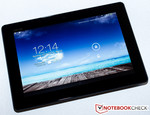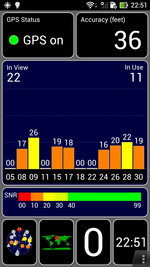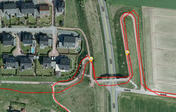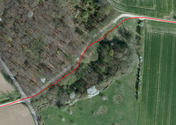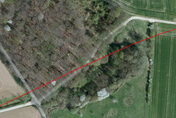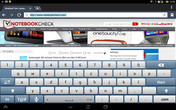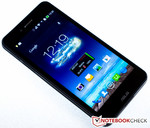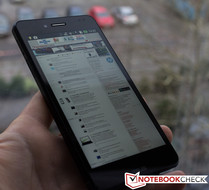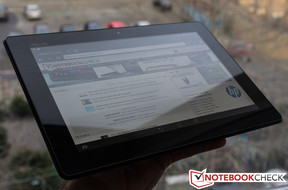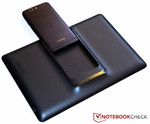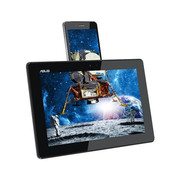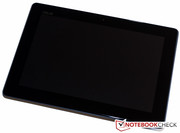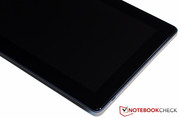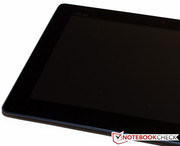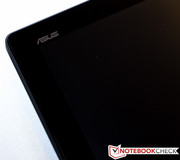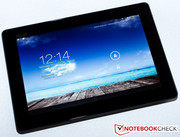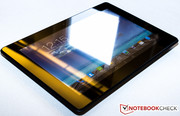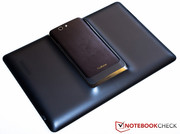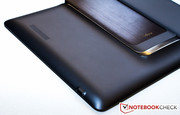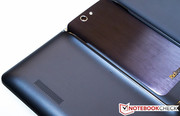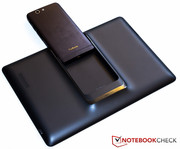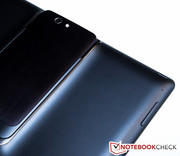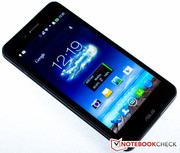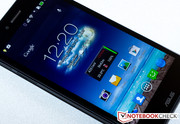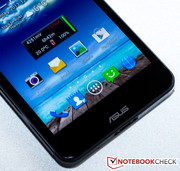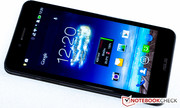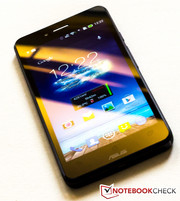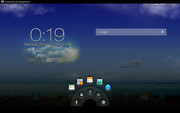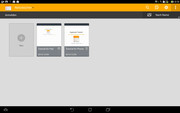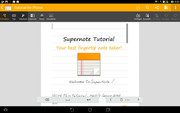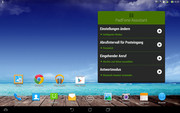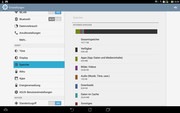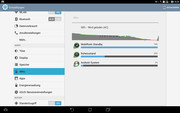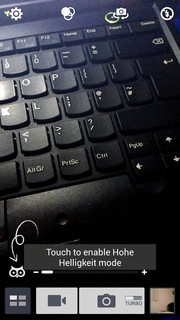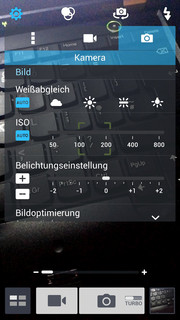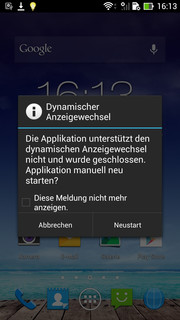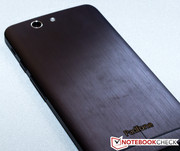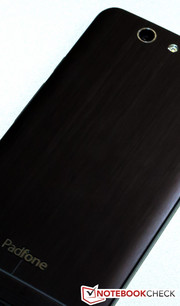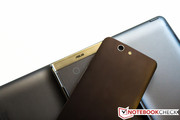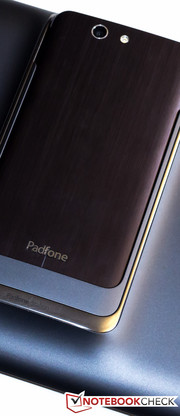Review Asus New Padfone Smartphone

For the original German review, see here.
Our former reviews of the Asus Padfone already showed that it is a very interesting concept. Most users have their smartphone with them all the time, so it is not a bad idea to combine it with a tablet. Asus finally offers the tablet as a separate device in the fourth generation. One important factor for the moderate interest for the Padfones is that Asus has to design two very good devices. If the performance of the smartphone would not be sufficient, for example, it would also affect the tablet and the potential buyer would probably look for another device from the competition.
A Snapdragon 800 and 2 GB memory suggest very high performance. Both displays also have the Full HD resolution and every device has its own battery. A first hands-on with the unique combination was very interesting and we decided to review it.
Case
The case of the smartphone has a very high build quality and is almost completely made of metal. The structured material is very resistant against concentrated pressure and twisting. The tablet on the other hand is made of polycarbonate, which leaves a good impression. Dimensions of 143.5 x 72.8 x 8.9 mm (~5.7 x 2.9 x 0.4 inches) are typical for 5-inch smartphones, but it is slightly smaller and wider than the LG G2 (138.5 x 70.9 mm; ~5.5 x 2.8 inches and 5.2-inch display) or the Nexus 5 (137.84 x 69.17 mm; ~5.4 x 2.7 inches). The smartphone of the New Padfone is noticeably heavier than the Nexus 5 (130 vs. 145 grams; ~4.6 vs. 5.1 ounces) and the tablet weighs 532 grams (~18.8 ounces) - pretty much the same as the Samsung Galaxy Note 10.1 2014.
Thanks to the rounded edges, the heart of the New Padfone feels very comfortable in the hands and the same applies for the tablet with its rounded sides. The tray for the smartphone is unfortunately protruding, so the tablet wiggles on a flat surface.
Connectivity
You cannot remove the back cover of the smartphone, so all the ports and buttons have to be located on the edges. A 3.5 mm stereo jack is on the top and the micro USB port, which is also the docking port, is on the opposite side. The Nano SIM tray is on the left side next to the SD card reader for cards with a capacity of up to 64 GB. The power button and volume rocker are on the right side.
The tablet has one USB port on the right side of the case, which can be used to recharge both batteries and establish a connection with a computer. The power button and volume rocker are on the upper left corner.
Software
The operating system is Android 4.2, so the tablet-smartphone combination is not completely up to date. We hope that the manufacturer will offer a direct update to KitKat (Android 4.4) and waive the step to version 4.3. The current information suggests that the update will be available in the second quarter of 2014.
Asus preinstalled its own launcher and added a lot of preloaded software. There are more or less useful Apps for almost every situation. This is definitely not a stock operating system, but this is not a reason for criticism as long as the performance is not affected.
Communication & GPS
All communication modules are inside the smartphone. This is also evident if you try to use the tablet without the smartphone. The WLAN module (dual-band) supports the 802.11 ac/b/g/n standards and provides a very good and constant signal quality. An LTE module ensures connectivity away from wireless networks and can receive data with up to 150 Mbps (if you have the required data plan). Bluetooth 4.0 can be used for short-range transfers and the Padfone is even equipped with an NFC module.
The aGPS module quickly finds the satellites, both with and without the attached tablet. Once the connection is established, it is also very stable and navigating with additional software from the Play Store is no problem. We could not determine any accuracy or stability problems during our test walk with the free applications Google Maps and GPS Test. A direct comparison with the outdoor solution from Garmin however shows some differences. The route on the bridge is not very accurate on the Padfone and the software only records the linear distance of our forest drive. The result is a difference of more than 100 meters (~109 yards) in our case. The New Padfone is far away from an excellent result like the Apple iPhone 5S, for instance.
Telephone Functions and Voice Quality
You can obviously still make or get calls when the New Padfone is connected with the tablet. It is hard to plan calls and it would not be very practical if you could not take the call when the smartphone is docked. Due to its size, the tablet is not perfect for the handling and you should detach the smartphone - this is of course possible during a call. The voice quality is very good and both parties are loud enough. We could not determine any background noise or other issues in our test. The provided in-ear headset can also be used instead of the hands-free feature.
Cameras & Multimedia
The Padfone has three camera modules: The main camera is on the back of the smartphone and has a 13 MP sensor. An LED flash supports the camera in bad lighting environments. An aperture of f/2.0 should result in good pictures, at least in theory. The smartphone is also equipped with a front camera with the same aperture (f/2.0) and a resolution of 2 megapixels. You cannot use the front camera of the smartphone when it is connected with the tablet, but the latter has a front camera as well - the resolution is unfortunately limited to 1 MP.
Our sample pictures with the main camera show a very high saturation. This is especially evident in our environment shot. The presentation of the right garden shed is not very accurate, and the same applies for the scene shot. Macro shots however work really well and the whole image foreground is sharp.
Accessories & Warranty
The New Padfone comes in a very stylish dark box. Provided accessories are limited to the modular power supply unit and an in-ear headset.
Warranty information can be found in the several quick start guides. The device has a warranty of 24 months after the initial purchase. If you do not have the receipt or the invoice, the production date of the device will be the beginning of the warranty period.
Input Devices & Handling
The characteristic feature of the New Padfone is the concept of a combined and separate use of smartphone and tablet. As a result, you get two touchscreens. Both displays are capacitive and can recognize up to ten inputs simultaneously. They are very precise and do not cause any criticism. Inputs are also executed very quickly and without delays, and the same applies for the display rotation (90 degrees). We really like the position of the navigation bar under the touchscreen at the bottom edge of the smartphone. The navigation bar is part of the touchscreen with many devices like the LG G2 or the Nexus 5 and occupies a part of the display surface.
A virtual keyboard can be used for inputs. It occupies between 45 and 55 percent of the smartphone (portrait mode) and also around 50 percent when the smartphone is connected with the tablet and you use it in landscape mode. The situation is better when you use the tablet in portrait mode. To improve the typing it always displays an additional row with numbers. You can also find many alternatives in the Play Store that occupy less space, the App Minuum Keyboard, for instance, is very minimalistic.
Display
The 5-inch IPS display of the smartphone has a resolution of 1920x1080 pixels (Full HD) and a pixel density of 440.6 ppi. The New Padfone is therefore on one level with current high-end devices like the Google Nexus 5, Samsung Galaxy S4, LG G2 or HTC One. The tablet also has the Full HD resolution, but there are some additional pixels in height, which result in a resolution of 1920x1200 pixels.
First, we have a closer look at the smartphone, because it is also sold separately and it is the most important component of our system. Our X-Rite i1Pro 2 determines an average brightness of 382.7 cd/m² and an excellent brightness distribution of 94 percent. The black value of 0.27 cd/m² is very low, which results in a very high contrast ratio of 1,411:1. This brilliant combination of black value, contrast and brightness distribution is unfortunately very rare, so we are really happy that Asus managed to use such a high-quality panel for the New Padfone.
The average brightness of the tablet is slightly lower at 353.6 cd/m², but it is still very bright nonetheless. The black value on the other hand is significantly worse at 0.56 cd/m², which also affects the contrast ratio. As mentioned before, the smartphone is also available without the tablet.
| |||||||||||||||||||||||||
Brightness Distribution: 94 %
Center on Battery: 381 cd/m²
Contrast: 1411:1 (Black: 0.27 cd/m²)
ΔE ColorChecker Calman: 5.83 | ∀{0.5-29.43 Ø4.78}
ΔE Greyscale Calman: 4.54 | ∀{0.09-98 Ø5}
Gamma: 2.95
CCT: 7228 K
| |||||||||||||||||||||||||
Brightness Distribution: 83 %
Center on Battery: 386 cd/m²
Contrast: 689:1 (Black: 0.56 cd/m²)
ΔE ColorChecker Calman: 3.71 | ∀{0.5-29.43 Ø4.78}
ΔE Greyscale Calman: 3.25 | ∀{0.09-98 Ø5}
Gamma: 2.4
CCT: 6149 K
One common drawback of both displays is the color accuracy. We can quickly see that red colors are too pale on the smartphone display, and the result is a visible blue cast. The average DeltaE-2000 value of 5.83 is too high and cannot keep up with the excellent result of the Nexus 5. Similar compromises can be seen with the grayscale presentation, because the results are far away from the ideal values. The result is a high color temperature of 7,228 K.
It is quite the opposite with the tablet, where blue colors are too pale. However, the average DeltaE-2000 value of 3.71 is surprisingly low in return. We can see an almost perfect result for the grayscale presentation and the average color temperature is much closer to the ideal value with 6,149 K.
Thanks to the high brightness and the excellent contrast, it is no problem to use the smartphone outdoors. It does have a glossy display, but the mentioned characteristics can compensate that for the most part. You can also buy an anti-reflective display protection to improve the visibility even further. The tablet on the other hand has more problems under the sky with a lower average brightness and a worse black value. You will definitely see a difference between the two displays outdoors.
Performance
You can buy our review bundle separately, but you should consider that the tablet does not work without the smartphone. Only the 5-inch device has an SoC and the other necessary hardware components for the operation. The tablet is basically just a docking station with a display and an additional battery.
The SoC of the New Padfone is a Qualcomm Snapdragon 800 with four cores. The processor runs at 2.2 GHz and the GPU (Adreno 330) at 450 MHz. Both components use a shared memory of 2 GB.
We used several benchmarks to evaluate the performance of the New Padfone, but the smartphone was not connected with the tablet. The performance difference with the attached tablet is negligible; the only difference is the slightly higher display resolution of the tablet. We were surprised about some synthetic benchmark results. The very powerful LG G2 is almost always behind the New Padfone and the Nexus 5 has even bigger problems to keep up with the performance of our review unit. Compared to the Samsung Galaxy Note 10.1 2014 however, we can see that a full tablet is still more powerful (and the competitor also has 3 GB memory).
| GFXBench (DX / GLBenchmark) 2.7 | |
| T-Rex Onscreen (sort by value) | |
| Asus New Padfone | |
| LG G2 | |
| Google Nexus 5 | |
| Samsung Galaxy Note 10.1, 2014 Edition | |
| Samsung Galaxy S4 GT-I9505 | |
| Apple iPad Air 1 2013 | |
| 1920x1080 T-Rex Offscreen (sort by value) | |
| Asus New Padfone | |
| LG G2 | |
| Google Nexus 5 | |
| Samsung Galaxy Note 10.1, 2014 Edition | |
| Samsung Galaxy S4 GT-I9505 | |
| Apple iPad Air 1 2013 | |
| (sort by value) | |
| Asus New Padfone | |
| LG G2 | |
| Google Nexus 5 | |
| Samsung Galaxy Note 10.1, 2014 Edition | |
| Samsung Galaxy S4 GT-I9505 | |
| Apple iPad Air 1 2013 | |
| Epic Citadel - Ultra High Quality (sort by value) | |
| Asus New Padfone | |
| LG G2 | |
| Google Nexus 5 | |
| Samsung Galaxy Note 10.1, 2014 Edition | |
| Samsung Galaxy S4 GT-I9505 | |
| 3DMark | |
| System (sort by value) | |
| Samsung Galaxy S4 GT-I9505 | |
| 1280x720 offscreen Ice Storm Unlimited Score (sort by value) | |
| Asus New Padfone | |
| Google Nexus 5 | |
| Samsung Galaxy Note 10.1, 2014 Edition | |
| Apple iPad Air 1 2013 | |
The results of the browser benchmarks are fair to middling. Competitors with Android still have a hard time to beat the New Padfone, but this time our review unit has to face the Apple iPad Air, which turns out to be a harder task. The New Padfone can only beat the iPad Air in the WebXPRT 2013 benchmark - but it is still behind all the other rivals.
| Browsermark - --- (sort by value) | |
| Asus New Padfone | |
| LG G2 | |
| Google Nexus 5 | |
| Samsung Galaxy Note 10.1, 2014 Edition | |
| Samsung Galaxy S4 GT-I9505 | |
| Apple iPad Air 1 2013 | |
| Mozilla Kraken 1.0 - Total (sort by value) | |
| Asus New Padfone | |
| LG G2 | |
| Google Nexus 5 | |
| Samsung Galaxy Note 10.1, 2014 Edition | |
| Samsung Galaxy S4 GT-I9505 | |
| Apple iPad Air 1 2013 | |
| Octane V1 - Total Score (sort by value) | |
| Asus New Padfone | |
| LG G2 | |
| Google Nexus 5 | |
| Samsung Galaxy Note 10.1, 2014 Edition | |
| Samsung Galaxy S4 GT-I9505 | |
| Apple iPad Air 1 2013 | |
| Peacekeeper - --- (sort by value) | |
| Asus New Padfone | |
| LG G2 | |
| Google Nexus 5 | |
| Samsung Galaxy Note 10.1, 2014 Edition | |
| Samsung Galaxy S4 GT-I9505 | |
| Apple iPad Air 1 2013 | |
| WebXPRT 2013 - Overall (sort by value) | |
| Asus New Padfone | |
| LG G2 | |
| Google Nexus 5 | |
| Samsung Galaxy Note 10.1, 2014 Edition | |
| Samsung Galaxy S4 GT-I9505 | |
| Apple iPad Air 1 2013 | |
* ... smaller is better
It appears that the LG G2 and the Asus New Padfone use a very similar flash storage. The performance is almost identical, except for one of four tests. All in all, we cannot criticize the read or write performance - quite the contrary. Asus' latest product can completely convince us in this section.
Games & Videos
One of the biggest hardware innovations in terms of SoC technology in 2013 is without a doubt the Snapdragon 800 from Qualcomm. It provides more than enough performance for current 3D games and our review unit had no problems with Need for Speed, Modern Combat 4: Zero Hour or GTA: Vice City.
Another feature of the SoC is the playback of QFHD movies. We used several trailers to check the performance. All the clips had data rates of up to 21 Mbps, but we could not determine any dropped frames or delays, neither when we used the smartphone nor the tablet. We used the preinstalled video player for our tests.
Emissions
Temperature
As usual, we evaluate the temperature development of the smartphone first. We can measure up to 38.3 °C (100.9 °F) and an average temperature between 36.5 °C and 34.1 °C (97.7 and 93.4 °F; front and back) under load. The results are on the same level as the LG G2. Idle operation is much cooler with an average temperature below 30 °C (86 °F). It even feels very cool because of the aluminum case. The device does not get much warmer when it is connected with the tablet since the smartphone still handles all the calculations. The hottest spot (39.8 °C; 103.6 °F) is at the back, where we insert the smartphone. Still, all temperatures (load and idle) are no problem and do not cause any criticism.
(+) The maximum temperature on the upper side is 38.3 °C / 101 F, compared to the average of 35.2 °C / 95 F, ranging from 21.9 to 247 °C for the class Smartphone.
(+) The bottom heats up to a maximum of 35.7 °C / 96 F, compared to the average of 34 °C / 93 F
(+) In idle usage, the average temperature for the upper side is 29.7 °C / 85 F, compared to the device average of 32.9 °C / 91 F.
Speakers
The location of the mono speaker on the New Padfone is quite unusual; the small indentation is on the right side above the power button. One advantage of this solution is that you usually do not cover it with your hands, which would result in distortions. The maximum volume is very low compared to other rivals. However, the manufacturer does avoid a distorted sound. You should not expect too much from the small speaker, it is far away from a clear and convenient sound experience.
It is unfortunate that Asus did not equip the tablet with at least two speakers. The one speaker is also located on the left side of the case, so the sound only comes from one direction. It gets even worse when you put the tablet on a flat surface. Distortions are also present at around 80 percent of the maximum volume.
Energy Management
Power Consumption
The smartphone consumes between 3.2 and 5.7 Watts under load. It is more frugal during idle with 0.3 and 1.6 Watts. The LG G2 is more frugal in both cases and also has a larger battery - but more on that later.
We can measure up to 10.2 Watts with the attached tablet, which is very similar to the Galaxy Note 10.1 2014 (10.7 Watts). Web browsing will result in consumption between 3.3 and 6.6 Watts. The minimum consumption of the Galaxy Note 10.1, with activated display, is much lower compared to the New Padfone with 1.7 Watts.
| Off / Standby | |
| Idle | |
| Load |
|
| Off / Standby | |
| Idle | |
| Load |
|
Key:
min: | |
Battery Runtime
The combined battery capacity of the smartphone and the tablet is 7,400 mAh. 2,400 mAh are provided by the smartphone and 5,000 mAh are from the tablet battery (Galaxy Note 10.1: 8,200 mAh; LG G2: 3,000 mAh). Neither the smartphone nor the tablet battery has a very large capacity, and we can see the result in our runtime tests. The smartphone battery only manages 2 hours and 21 minutes under load, but the situation is better in our WLAN scenario with a little more than 12 hours. Our idle test resulted in a maximum runtime of 14 hours and 50 minutes and a complete recharging takes 2:36 hours. Our tests with the tablet showed that the tablet battery is used first. You will have to recharge the tablet after 6 hours and 46 minutes web browsing, but the battery of the smartphone is still completely charged and can be used.
Verdict
Asus offers a very interesting smartphone-tablet combination in its fourth generation with the New Padfone. Realizing such a project is anything but easy because the manufacturer has to design two excellent products. A high-end smartphone, which can compete with the current flagships, and a tablet with similar qualities. There were numerous reports about the problems and unique characteristics of the device in the past, but it is finally possible to buy the two devices separately. However, you have to consider that the tablet only works with the attached smartphone. The important components, for example SoC, memory and flash storage, are inside the smartphone.
We are convinced by the concept of the Padfone. One person can only use one device at a time and we already know the concept from notebooks. Thanks to docking stations, you can comfortably connect the small notebook display with a larger external display. Even though there were some issues with the Padfone concept in the past, most of them have been addressed and solved. You should have a closer look at the New Padfone from Asus if you are looking for a new high-end smartphone and an Android tablet for web browsing on the couch. We can also recommend the smartphone without the tablet - the performance is on the same level with the LG G2 and the Nexus 5. The bundle is currently available for around 800 Euros (~$1094), and the smartphone alone retails for around 550 Euros (~$752).




